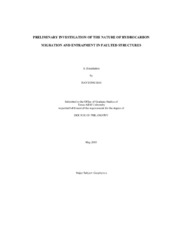| dc.contributor.advisor | Watkins, Joel S. | |
| dc.creator | Bai, Jianyong | |
| dc.date.accessioned | 2004-09-30T02:01:17Z | |
| dc.date.available | 2004-09-30T02:01:17Z | |
| dc.date.created | 2005-05 | |
| dc.date.issued | 2004-09-30 | |
| dc.identifier.uri | https://hdl.handle.net/1969.1/449 | |
| dc.description.abstract | Numerical simulations indicate that hydrocarbon migration and entrapment in stacked fault-bounded reservoirs are mainly affected by the following factors: charge time, faults, pressure and geological structures. The charge time for commercial hydrocarbon accumulation is much longer in oil-water systems than in oil-gas-water systems.
Faults are classified into charging faults and 'back doors' faults other than charging faults in stacked fault-bounded reservoirs. The lower the displacement pressure of a fault, the higher its updip oil transportation ability. The downdip oil transportation ability of a fault is usually low and cannot cause commercial downdip oil accumulation.
Back doors affect both hydrocarbon percent charge and hydrocarbon migration pathways. Updip back doors improve updip oil charge. The lower the displacement pressure of an updip back door, the more efficient the updip oil charge before 3,000 years. Back doors whose displacement pressure is equal to or higher than 28.76 psi are effective in sealing faults in oil-water systems. On the contrary, only sealing faults result in commercial gas accumulations in stacked fault-compartmentalized reservoirs. Otherwise gas is found over oil. Downdip back doors generally have few effects on downdip hydrocarbon charge.
Geopressure enhances the updip oil transportation of a fault and improves the positive effects of updip back doors during updip oil charge. Geopressure and updip back doors result in more efficient updip oil charge. A physical barrier is not necessarily a barrier to oil migration with the aid of geopressure and updip back doors.
The chance for hydrocarbon charge into reservoirs along growth faults is not equal. Any one of the above controlling factors can change the patterns of hydrocarbon charge and distribution in such complex geological structures. Generally, lower reservoirs and updip reservoirs are favored. Reservoirs along low-permeability charging faults may be bypassed. Gas can only charge the updip reservoirs. Both updip and downdip back doors can facilitate oil penetrating a barrier fault to charge reservoirs offset by the barrier fault.
Interreservoir migration among stacked fault-compartmentalized reservoirs is an important mechanism for hydrocarbon accumulation and trap identification. The interreservoir migration is a very slow process, even though the displacement pressures of bounding faults may be very low. | en |
| dc.format.extent | 4409533 bytes | en |
| dc.format.extent | 206263 bytes | en |
| dc.format.medium | electronic | en |
| dc.format.mimetype | application/pdf | |
| dc.format.mimetype | text/plain | |
| dc.language.iso | en_US | |
| dc.publisher | Texas A&M University | |
| dc.subject | Seismic exploration | en |
| dc.subject | hydrocarbon migration and entrapment | en |
| dc.subject | interreservoir migration | en |
| dc.subject | back door faults | en |
| dc.subject | percent charge | en |
| dc.subject | capillary pressure | en |
| dc.subject | displacement pressure | en |
| dc.subject | geopressure | en |
| dc.title | Preliminary investigation of the nature of hydrocarbon migration and entrapment | en |
| dc.type | Book | en |
| dc.type | Thesis | en |
| thesis.degree.department | Geology and Geophysics | en |
| thesis.degree.discipline | Geophysics | en |
| thesis.degree.grantor | Texas A&M University | en |
| thesis.degree.name | Doctor of Philosophy | en |
| thesis.degree.level | Doctoral | en |
| dc.contributor.committeeMember | Gibson, Richard | |
| dc.contributor.committeeMember | Blasingame, Thomas A. | |
| dc.contributor.committeeMember | Johnson, Brann | |
| dc.contributor.committeeMember | Ikelle, Luc T. | |
| dc.type.genre | Electronic Dissertation | en |
| dc.type.material | text | en |
| dc.format.digitalOrigin | born digital | en |


